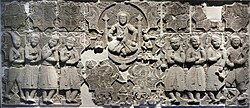Xueyantuo
Xue 薛 appeared earlier as Xinli 薪犁 in Sima Qian's Records of the Grand Historian, vol.[2][3] Golden (2011) proposed that 薛 Xue's Old Turkic form Sir derived from Sanskrit Śrī "fortunate, auspicious"[4] The etymology of Yantuo 延陀 is much debated.In the time of Former Yan [emperor] Murong Jun, Xiongnu Shanyu Helatou led his tribe, numbering 35,000, to come surrender.Consequently, they abandoned the Western Turks and established their own Khaganate under a leadership of Qibi tribe's Yağmurčin Bağa-Qağan, retaining the control and income from the Turfan segment of the Silk Road.[15] "Raising Yi'nan on Kagan throne was done under pressure from the Tang court interested in stripping El-kagan of the rights to the supreme power in the huge region, and also in final dismemberment of the Türkic state, a source of many conflicts on their northern borders.The plot failed, as he was unable to gather his people, many of his tribesmen having escaped to the south by 644 after a series of unsuccessful incursions by the Xueyantuo supported by the Tang dynasty.The epitaph of Shatuo leader Li Keyong states that his clan's progenitor was "Yidu, Lord of the Xueyantuo country, an unrivaled general" (益度、薛延陀國君、無敵將軍).However, Chinese chroniclers also traced the Shatuo's origins to a Tiele chief named *Bayar (拔也 Baye)[28] ~ *Bayïrku (拔也古 Bayegu)[29] or Western Turkic Chuyue 處月 (often identified with Chigils).[35] It is possible that Bo was influenced by the Tongdian, which refers to the Xueyantuo surname as Yilitu 壹利吐, Yiliduo一利咄 as in Cefu Yuangui, Yilidie 壹利咥 as in New Book of Tang.





Old TurkicShamanismTengrismTribalconfederationMiddle AgesFirst Turkic KhaganateEastern Turkic KhaganateTang dynastySecond Turkic KhaganateChineseStandard MandarinHanyu PinyinWade–GilesMiddle ChineseWestern Turkic KhaganateKhazar KhaganateTürgesh KhaganateUyghur KhaganateKarluk Yabghu StateOghuz Yabgu StateKara-Khanid KhanateYenisei Kyrgyz KhaganateCuman–Kipchak confederationGhaznavid EmpireSeljuk EmpirekhaganateNortheast AsiaGöktürksEastern GöktürksSima QianRecords of the Grand HistorianGoldenVilhelm ThomsenNew Book of TangKül TiginTongdianMurong JunFormer YanXiongnuchanyuAlat tribePugu YituShoroon Dov KurganShoroon Bumbagar tombShanyuQaghanateZhenzhu KhanDuomi KhanYitewushi KhanChuluo KhaganQibi tribeYağmurčin Bağa-QağanShekuiUighurBarsilIllig QaghanYukuk ShadInčü Bilge-KhaganTatarsAltai MountainsGobi DesertEmperor Taizong's campaign against Eastern TujueYin Mountainswarring with the TangQilibi KhanQarluqUlungurIrtysh RiverChuluo KhanAshina JiesheshuaiEmperor Taizong's campaign against XueyantuoUyghurLi DaozongLatter TurkBilge KhaganKipchaksShatuoLi KeyongWestern TurkicChigilsHistory of the Turkic peoplesTurkic peoplesOnogursOghuz TurksSaragursUtigursBulgarsKutrigursKarluksCherniye KlobukiUyghursKumyksYakutsDolgansKrymchaksCrimean KaraitesTurkic LanguagesTurkishAzerbaijaniKazakhTurkmenKyrgyzBashkirChuvashQasgqaiKarakalpakKarachay-BalkarGagauzKaraimKrymchakTurkic MythologyÜlgenErgenekonGrey wolfPre-14th centuryYenisei Kyrgyz PeopleDinglingTiele (Gaoche) Tokhara YabghusTurk ShahisSabiri PeopleKangar UnionTurk ShahiKimek–Kipchak ConfederationKarluk Yabgu State